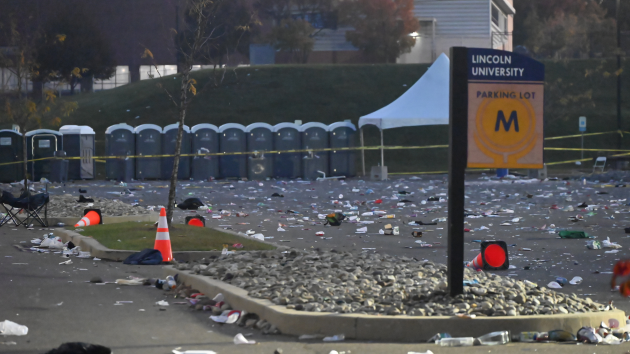The challenges to US security posed by ‘salad bar’ extremism
Written by ABC Audio ALL RIGHTS RESERVED on May 31, 2023

(WASHINGTON) — A Hispanic man accused of shooting and killing eight people at an outlet mall in Texas earlier this month held a mix of views consistent with neo-Nazism and involuntary celibate extremist ideologies, authorities said.
Though a motive for the suspect, who was shot and killed by a police officer, remains under investigation, the mass shooting appears among recent examples that highlight a “persistent and lethal threat” to U.S. security posed by “lone offenders and small groups motivated by a range of ideological beliefs and personal grievances,” the Department of Homeland Security said in a recent bulletin.
This type of threat is what’s often referred to by FBI director Christopher Wray as “salad bar” extremism. In the U.K., it’s known by the acronym MUU — mixed, unstable or unclear. Security firm Valens Global calls the phenomenon “composite violent extremism.”
The terms broadly refer to “idiosyncratic patterns of radicalization,” according to Daveed Gartenstein-Ross, the CEO of Valens Global who leads a project on domestic extremism for the Foundation for Defense of Democracies, a nonpartisan research institute focusing on national security and foreign policy.
“Traditionally, terrorism is thought of as being largely nested within a single ideology,” Gartenstein-Ross told ABC News. “What we’re seeing is violent extremists who display an amalgamation of different disparate beliefs, interests and grievances.”
This pattern of radicalization has “taken on increasing salience in recent years,” with an uptick within the last decade, Gartenstein-Ross said.
Examples of this, he cited, include Frank James, who pleaded guilty to federal terrorism charges for a 2022 shooting in the New York City subway; Nikolas Cruz, who was sentenced to life in prison for the 2018 mass shooting at South Florida’s Marjory Stoneman Douglas High School; and Zale Thompson, who was shot and killed by NYC police officers after attacking them with an ax in 2014.
John Cohen, a former U.S. Department of Homeland Security acting undersecretary for intelligence and ABC News contributor, points to several factors that are contributing to this phenomenon in the U.S., including a highly-polarized society in which some people feel that violence is acceptable, and an online and media environment that is “saturated” with extremist content.
“You spend time online, you not only can find the justification for the conduct of that attack, but you can find content that will provide you detailed instructions on how to do it,” Cohen said.
Gartenstein-Ross said he feels that the idiosyncratic ideologies reflect people, in general, taking on very disparate ideas in today’s information and social media environment.
“We as a people are becoming more incoherent,” he said. “Extremists are becoming more incoherent as well.”
Such extremists may pop up on law enforcement’s radar prior to attacks — such as a concerned call from a family member — but the U.S. lacks a “cohesive strategy” in the investigation and prevention of this threat, according to Cohen.
“This is the most complex, dynamic and dangerous threat environment I’ve experienced — and I include in that the months following Sept. 11,” Cohen said. “The reason I say that is because we’re not adapting to address this [type of] threat, and it’s a threat that potentially impacts every city and town across the United States.”
Composite violent extremism poses several challenges to law enforcement, Gartenstein-Ross noted, from determining when someone who is ideologically idiosyncratic becomes a threat to how to best intervene, to how to define their community.
“We understand where jihadist groups exist, we can see very concretely what the neo-Nazi white supremacist sphere is,” Gartenstein-Ross said. “For idiosyncratic, violent extremism, what’s the digital or real-world community that forms a part of the extremist’s familia?”
There is also an “unsettled” methodology in determining this type of extremist’s core beliefs, Gartenstein-Ross said.
“I firmly believe these are things we can crack,” he continued. “A lot of these are new questions based on the increased prominence of idiosyncratic radicalization patterns.”
Cohen said addressing the threat will entail strategies from the local to federal level.
“We have to employ not just traditional law enforcement strategies to address it, but also community-based threat management strategies that involve collaborative efforts involving mental health professionals, law enforcement, community groups, faith leaders,” he said.
Educating both the public on the behaviors of these types of extremists so they know when to alert authorities, and front-line responders on how to respond, is also key, he said.
Common behaviors often exhibited by violent extremists, who tend to be people “who exist on the fringe of the community,” include publicly expressing anger and grievances; spending significant time online consuming violent and extremist content; acquiring firearms, ammunition and tactical gear; posting photos with that gear; and “making statements that represent an articulation of an intent to engage in violence,” Cohen said.
“We need to make sure that those calls are answered and that local authorities have a process in place to evaluate those behaviors — not just from the perspective of, has a crime been committed, but from the perspective of, is this person exhibiting behaviors that we know to be associated with somebody who may be preparing to conduct a mass casualty attack?” Cohen said.
Copyright © 2023, ABC Audio. All rights reserved.

 KVSP
KVSP 




